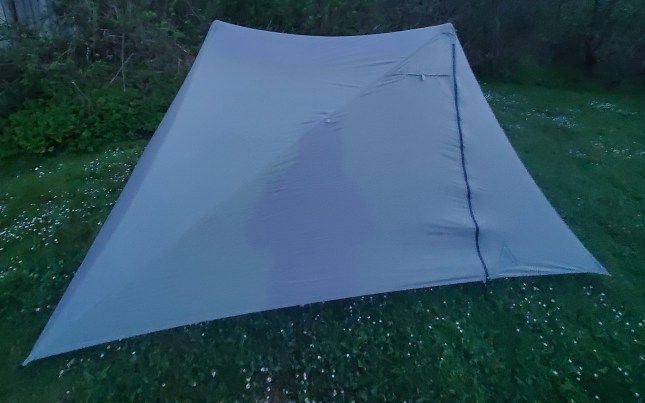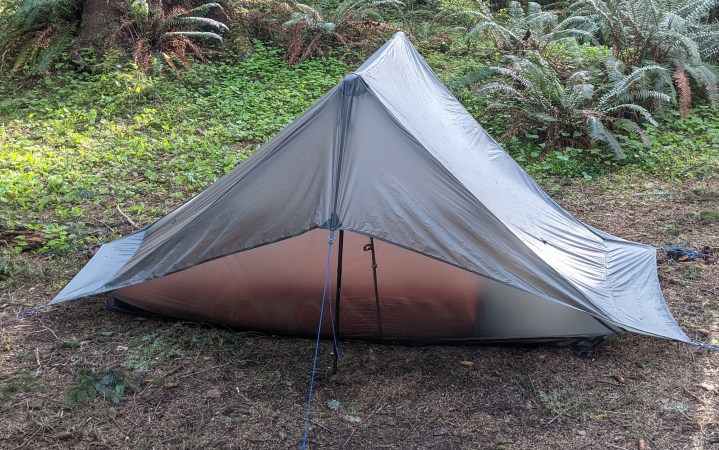We may earn revenue from the products available on this page and participate in affiliate programs. Learn More ›
There’s something magical about how ultralight tents push the envelope of protection for weight with their innovative designs and materials. Out of a sheet of wafer-thin fabric and a single trekking pole, you can make shelter suitable to withstand a range of three-season weather scenarios. Our only real complaint about ultralight tents is that you can’t just go to a big box showroom and see them all set up side by side: Some of the best out there are made by smaller cottage companies that simply don’t have that kind of reach. So for the inaugural Outdoor Life backpacking gear test, we took a dozen of the best ultralight tents along a section of the 362-mile Oregon Coast Trail to see which would impress our experienced tester group. For the parameters of this test, we defined ultralight as weighing less than 2.5 pounds for a one-person tent, with a focus on tents with or unique designs.
- Best Overall: Gossamer Gear The ONE
- Best Value: Durston X-Mid 1
- Best Freestanding: MSR Freelite
- Best Single Pole Set Up: Six Moons Lunar Solo
- Best for Groups: Seek Outside Cimarron
- Best for Tall People: Tarptent Protrail
- Lightest: Zpacks Plex Solo
- Best Eco-Friendly: NEMO Hornet OSMO
| Tent | Free-standing? | Uses Trekking Poles? | Single or Double Wall? | Weight (Measured) | Interior Space L x W x H | Price | Setup Rating | Interior Space Rating | Value Rating |
| Gossamer Gear The One | No | Two | Single | 1 pound, 6.6 ounces | 84” x 33” x 45” | $300 | 4 | 4.5 | 5 |
| NEMO Hornet OSMO | Yes | No | Double | 2 pounds, 4 ounces | 87” x 43” x 39” | $400 | 5 | 3 | 4 |
| Tarptent Protrail | No | Two | Single | 1 pound, 8.2 ounces | 84” x 42” x 45” | $240 | 2 | 2.5 | 4 |
| MSR Freelite | Yes | No | Double | 1 pound, 14.5 ounces | 87” x 33” x 39” | $420 | 5 | 3.5 | 4 |
| Big Agnes Tiger Wall UL | Yes | No | Double | 2 pounds, 2 ounces | 84” x 38” x 39” | $400 | 5 | 4 | 4 |
| KUIU Summit Star | No | One | Double | 2 pounds, 8 ounces | 111” x 90.5” x 51.2” | $476 | 1 | 4 | 3 |
| Outdoor Vitals Fortius | No | Two | Single | 1 pound, 10.1 ounces | 88” x 28” x 49” | $290 | 3 | 4 | 4 |
| Samaya Opti 1.5 | No | Two (or four) | Single | 1 pound, 15.2 ounces | 86” x 43” x 43” | $1,450 | 1 | 4 | 2 |
| Seek Outside Cimarron | No | No | Single | 3 pounds, 7 ounces | 114” x 102” x 72” | $662 | 5 | 5 | 5 |
| Durston X-Mid 1 | No | Two | Double | 2 pounds, 1 ounce | 90” x 32” x 43” | $240 | 4 | 3.5 | 5 |
| Six Moons Lunar Solo | No | One | Single | 1 pound, 12.9 ounces* | 90” x 48” x 49” | $275** | 4 | 3 | 4 |
| Stone Glacier SkyTarp 10 | No | Two | Single (tarp) | 1 pound, 2.2 ounces | Depends on the pitch | $190 | 2 | 4 | 4 |
| Zpacks Plex Solo | No | One | Single | 15.9 ounces* | 89” x 38” x 52” | $622** | 2 | 2 | 3 |
How We Evaluated the Best Ultralight Tents
Ultralight tents push the boundaries of what you can do with a sheet of DCF, a trekking pole, and a handful of titanium stakes. But with so many unique shapes and configurations, it can be hard to assess which will work best for your physical size and current backpacking kit, or the terrain you plan to travel through.

To help you choose the right tent for your needs and experience, five OL contributors and editors with over 20,000 miles of thru-hiking experience headed to the Oregon Coast Trail to test ultralight tents over five days in late April. The tents in our test ranged from UL mainstays like Zpacks, Gossamer Gear, and Six Moons to freestanding options from major-league brands like MSR, Big Agnes, and NEMO. We also tested tents from top backpack hunting gear companies, including KUIU, Stone Glacier, and Seek Outside as well as relative newcomers like Durston and Samaya.

On our multi-day section hike of the Oregon Coast Trail, we tested ultralight tents in as many configurations as possible: different terrains, weather conditions, and testers with different levels of experience. We experimented setting up the tents with nothing more than our wits and what was provided, but we also watched manufacturer instruction videos on loop to get it just so.
Each ultralight tent was evaluated in three categories and given a score of 1 (poor) to 5 (excellent) from each tester. Weight was also independently verified and based on what you need to carry to set up the tent that is not dual purpose (like a trekking pole). After discussing the scores and relative merits of each ultralight tent, we then determined and agreed upon the awards as a group. The categories were:
- Ease of set up: Tents were set up by multiple testers, allowing us to assess which were suitable for newbie ultralighters and which should be handled only by experienced backpackers and backpack hunters.
- Interior living space: Most backpackers will spend eight or more hours a day sleeping—that’s a third or more of your time out on the trail. A tent that feels claustrophobic or cramped will make for a worse outdoors experience and potentially negatively affect your sleep at night. We assessed the usable space in each tent, noting how the slope of pitch or vestibule size changed our experience.
- Value: The price of an ultralight tent can vary wildly, from a couple hundred dollars to upwards of six hundred dollars—the most expensive ultralight tent we looked at cost well over a thousand. We ranked each tent on whether the setup, weight, and liveability is merited by the price point.

While we did grade for protection and condensation, we ultimately chose not to include those rankings here. We had very good weather during the window we were testing along the Oregon Coast. However, we did deal with condensation in the tents, due to the comparatively cool temperatures and high humidity along the coast. At night, you could see the droplets of water in the air with your headlamp. Within an hour of being pitched, the interior walls of every tent was wet, even before the tester got inside. We have included our notes below on how that condensation affected the gear inside our tents, but were unable to determine the comparative ability of each tent to vent under these conditions.
For this test, we looked primarily at one-person shelters, and have noted the dimensions and overall usable space for the one-person version of each model, as well as when a two- or three-person model is available.
The Best Ultralight Tents of 2024: Reviews & Recommendations
Best Overall: Gossamer Gear The One
Best Overall
Gossamer Gear The One
Report Card
- Measured Weight: 1 pound, 6.6 ounces
- Ease of Setup: 4
- Interior Living Space: 4.5
- Value: 5
Key Features
- Price: $300
- Interior Dimensions: 84 inches long x 33 inches wide x 45 inches high (width tapers to 21 inches at the foot)
- Requires two trekking poles set to 125cm (fixed tent poles available for purchase)
- Stakes: Six required, two additional provided
- Materials: Ripstop nylon
- Also available as a two-person tent
Pros
- Easy to set up
- Reasonably priced
- Good sized interior that felt homey to our testers
Cons
- Requires two trekking poles to set up
The Gossamer Gear The One is the total package. It’s easy to set up, even for first-time ultralight tent users. It’s very light (third lightest in our test). It has enough head room to move around comfortably in the morning. The vestibule fit all our gear with room to spare. It packs up small. It even had an interior pocket stow pocket for odds and ends like eyeglasses. Check. Check. Check.
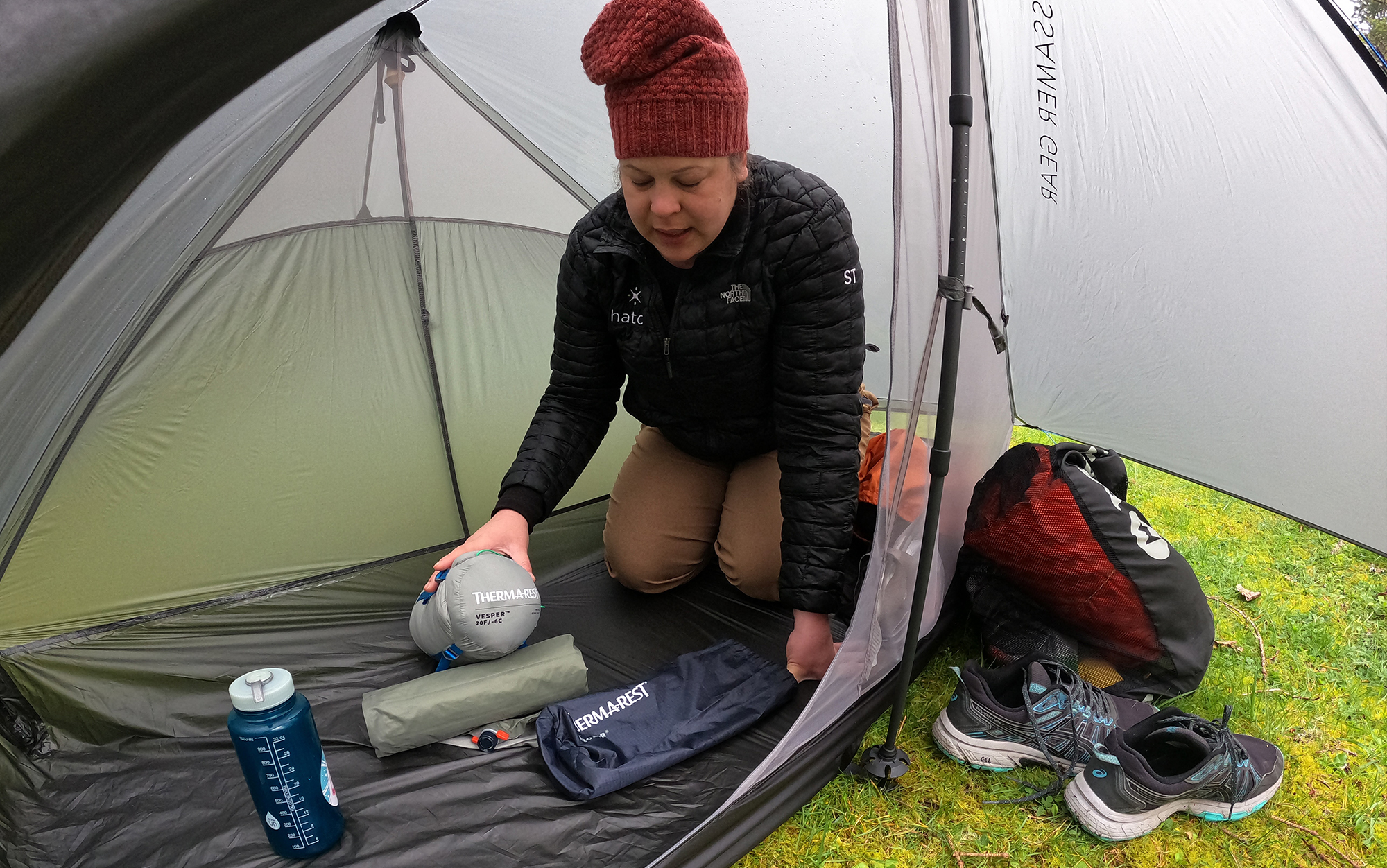
But this is the real reason it won the top slot: The Gossamer Gear The One, more than any other tent in our test, just had that je ne sais quoi that we look for in our home on the trail. Our testers wanted to be in this tent at the end of the day and were happy to wake up in it in the morning—even our tallest tester at 5 foot 10 inches. There was more wrangling to be the next tester for this tent than of any other we looked at.

Even though the Gossamer Gear The One wasn’t the lightest ultralight tent in our test (see our take on the Zpacks Solo Plex below), the upsides for that extra 6.7 ounces (better night’s sleep, more headspace, easier setup, zip at the door to protect against wind and rain) will be worth it to everyone but the most dedicated gram counters.
Both testers who took this tent out reported that they were able to figure out how to set up the tent without directions (something that was decidedly not true for all the ultralight tents in our test). However, they both noted the lack of directions provided in the package—consider downloading these to your smartphone before heading out into the field.
The only downside to this tent is that it requires two trekking poles to set up, making it less weight-conscious for backpackers who don’t already have trekking poles as part of their set up.
Best Value: Durston X-Mid 1
Best Value
Durston X-Mid 1
Report Card
- Measured Weight: 2 pounds, 1 ounce
- Ease of Setup: 4
- Interior Living Space: 3.5
- Value: 5
Key Features
- Price: $240
- Interior Dimensions: 90 inches long x 32 inches wide x 43 inches high (angled interior)
- Requires two trekking poles that can extend to 120cm (poles available for purchase)
- Stakes: Four required, two additional provided
- Materials: Polyester
- Also available as a one-pound DCF tent
Pros
- Excellent geometry makes for a stable set up
- Most vestibule space of anything we looked at
- Very affordably priced
Cons
- Not as light as some other ultralight tents in our test (DCF version is much more expensive)
- You’ll want to grab some different stakes (included options weren’t the best)
Consider us the newest members of the Dan Durston fan club. When set up correctly, the Durston X-Mid 1 had some of the best geometry of anything we looked at, fully taut and secure against wind and rain, not sagging in the slightest when serious moisture sets in. Even when it wasn’t set up perfectly (a loose stake popped on my first night in this tent), it was shockingly stable: I didn’t even notice until morning.

Even though the rainfly was soaked from the unrelenting condensation of the Oregon Coast, I was completely dry in this tent, thanks to its double-wall setup. What makes the Durston X-Mid 1’s double-wall set up especially unique is that it was designed to be pitched fly first—no additional groundsheet required. This is such a preferable order of operations in inclement weather that I hope this becomes the norm in the future. Our testers also noticed that the pitch had steeper walls than was typical, which maximizes livability—even if it doesn’t technically give you more floor space.

The Durston X-Mid 1 even had two doors and two vestibules. What one-person ultralight tent has a vestibule for your gear and a totally separate side for you to exit on for a midnight bathroom break? As far as we know, the Durston X-Mid 1 is the only one. This was also, along with the Tarptent Protrail, one of the lowest priced options in our test. Even though it’s a similar weight to the other double-wall ultralight tents we looked at, the Durston X-Mid 1 is (at the time of this review) about $200 less expensive. Hiker trash: this one is a no-brainer.

So what’s wrong with this tent? To start: it’s not your lightest option. For the same weight as the Durston X-Mid 1, you could get a fully freestanding tent. (Durston does offer a 1-pound version of this tent in DCF, but the price point for that is up there with the Zpacks Solo Plex.) Its setup also proved challenging for testers accustomed to freestanding tents: If this is your first trekking pole tent, give yourself some time and space to play around with perfecting the setup.
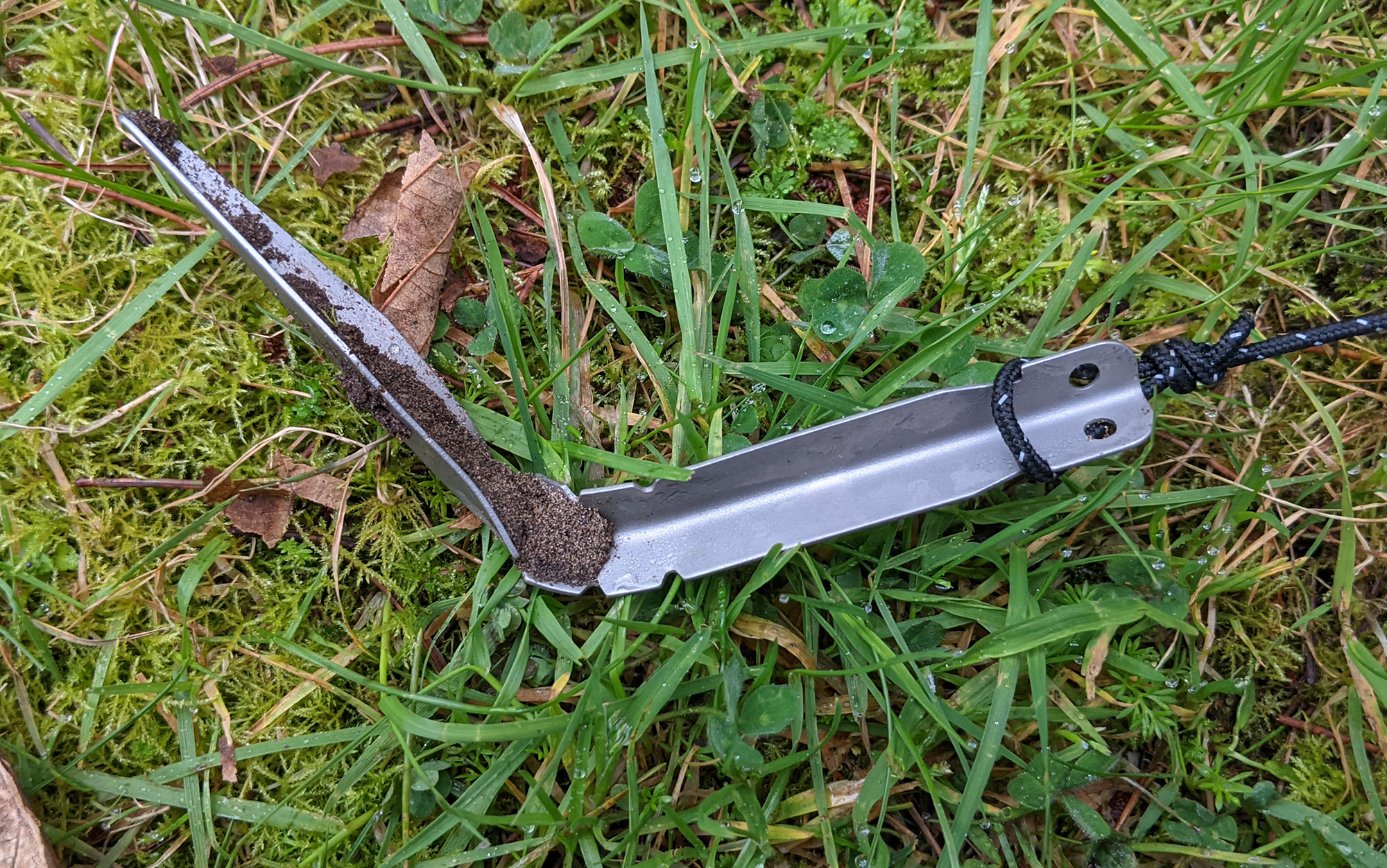
Finally, you remember I mentioned a stake popped out the first night we used this tent? That stake had bent while being pushed into reasonably soft ground. I’d plan to replace them with one of the best tent stakes, with an eye toward MSR Groundhog minis or Big Agnes Dirt Daggers.
Read our full review, Durston X-Mid 1 Review: A Beginner-Friendly Ultralight Shelter.
Best Freestanding: MSR Freelite
Best Freestanding
MSR Freelite
Report Card
- Measured Weight: 1 pound, 14.5 ounces
- Ease of Setup: 5
- Interior Living Space: 3.5
- Value: 5
Key Features
- Price: $420
- Interior Dimensions: 87 inches long x 33 inches wide x 39 inches high
- No trekking poles required
- Stakes: Five required, One additional provided
- Materials: Ripstop nylon
- Also available as a two-person tent or three-person tent
Pros
- Super easy setup
- Sub-2 pounds
Cons
- Smaller interior space than the other freestanding tents in this test
A freestanding tent that comes in under 2 pounds? If you are wondering what the catch is, so were we. Setting up the MSR Freelite was extremely fast (one tester set it up in under two minutes without having ever used it before), and it took minimal effort to achieve the storm-worthy profile. The interior, while not exactly spacious, was large enough for the biggest sleeping pad on our test (a full-size rectangular Therm-a-Rest NeoAir Xlite NXT), with a backpack fitting handily into the vestibule. Testers reported that it felt larger than it was, which is an important detail if you get stuck inside waiting out a storm. The mesh and fly were extremely lightweight and plenty robust, with the dirt falling right off when we shook it out before stuffing it away for the day. The poles (best-in-class DACs, naturally) were even made from aluminum, as opposed to splinter-prone carbon fiber. Our only concern was with that 15D bathtub floor—it may benefit from a groundsheet on more challenging terrains—but this was strictly theoretical as we didn’t experience any holes on our testing trip.

While there are plenty of thru-hikers who will prefer the weight savings of a single-wall tent, the extreme condensation of the Oregon Coast showed the advantages of a double-wall setup. While the rest of our testing team was carefully packing up for the day, avoiding the soaked sides of their single-walled tents lest they unleash a rainstorm on their sleep system, the tester in the MSR Freelite 1 could sit up, bump their head on the mesh at the top of the tent, and stay dry.
There are only a few small quibbles with this tent. One is the door: It’s on the small side compared to the rest of our field, forcing our tallest tester (5 foot, 10 inches) to pretzel her limbs more than she would have liked when getting out. The included stakes (needle stakes) are also lower quality compared to other options in the MSR arsenal. Consider upgrading to either the lightweight MSR Carbon Cores or the MSR Groundhog Minis, which have great holding power.
Best Single Pole Setup: Six Moons Lunar Solo
Best Single Pole Setup
Six Moons Lunar Solo
Report Card
- Measured Weight: 1 pound, 12.9 ounces (weight includes stakes; not included in purchase price)
- Ease of Setup: 4
- Interior Living Space: 3
- Value: 4
Key Features
- Price: $275 (price includes stakes; not included in base price)
- Interior Dimensions: 90 inches long x 48 inches wide x 49 inches high (widest at the middle, tapers at the head and foot)
- Requires one trekking pole set to 124cm (tent poles available for purchase)
- Stakes: Six required (not included in purchase price)
- Materials: Polyester
- Also available as a two-person tent
Pros
- Easy to set up
- Ability to adjust the door guyline from inside the tent
- Affordable
Cons
- Low walls can be claustrophobic
Maybe you’re like me: You don’t typically use trekking poles while hiking, but you’ve been known to toss one into your pack for gnarly river crossings or for extra stability on steep, snowy terrain. But there’s no way you’d carry two just to use in a trekking pole setup—at that point you might as well just use a freestanding model.
The Six Moons Lunar Solo was one of the few ultralight tents in our test that used one trekking pole in its design rather than two. The result was a modified teepee structure that was surprisingly intuitive to set up. Despite having never used this tent, I was able to put it up in only a couple of minutes with no directions.

It also had a few details I appreciated. The first was a vent on the top of the tent. It didn’t help with the unrelenting fog of the Oregon Coast, but in drier climes it would reduce condensation buildup from exhaling inside your tent. It also had a tension adjustment for the rainfly door inside the tent, a thoughtful detail that I haven’t seen before. This would allow you to get rid of excess slack (typically caused by wind or condensation) in the part of the tent covering your gear without having to get out of your tent.

While the peak height of this tent is sufficient, I found it difficult to avoid bumping my head against the condensation-soaked tent walls in the morning. This was in part due to my site location: I was pitched on slightly uneven ground, which made it difficult to achieve the steeply sloped walls that would have been possible on flat ground.

While this tent is affordably priced, note that the price does not include stakes; you’ll need to purchase those separately. (See our take on the best tent stakes for some ideas.)
Best for Groups: Seek Outside Cimarron
Best for Groups
Seek Outside Cimarron
Report Card
- Measured Weight: 3 pounds, 7 ounces
- Ease of Setup: 5
- Interior Living Space: 5
- Value: 5
Key Features
- Price: $662 (titanium stove is an extra $355)
- Interior Dimensions: 9 feet, 6 inches long x 8 feet, 6 inches wide x 6 feet high (11 foot, 8 inch length and 9 foot, 6 inch width when measured at the center pole)
- No trekking poles required
- Stakes: Eight required, two additional provided
- Materials: Ripstop nylon
Pros
- Straight-forward set up
- Lightweight for its size
- Came with some the best tent stakes of any tent I looked at
- Option to pair with a lightweight titanium stove
Cons
- Huge footprint can make it hard to find a suitable pitch site
- No floor (option to purchase a floor if you do not plan to use the stove)
I suspect I’m not alone when I say the idea of a so-called hot tent—a tent paired with a wood-burning stove—took some getting used to. Like most backpackers, I’m typically boiling water for my morning coffee in the vestibule while warily eyeing the explicit all-caps instructions to not use a stove in the tent. Starting an actual wood-burning fire in the tent would be out of the question. So it was with trepidation and a whole lot of excitement that I carted the Seek Outside Cimarron out for the third night of the Oregon Coast Trail testing trip.

Verdict: It’s great. First off, the Seek Outside Cimarron is an exceptionally easy tent to set up. The first step is to stake out the four corners of the tent, a task made easier by the long (almost 10 inches) twisted aluminum stakes—I was comfortable pounding these in with a rock and they held significantly better than any other stakes provided for this test of the best ultralight tents. Then simply assemble the pole sections together at the lowest length setting, position it in the center of the tent, and adjust it up until it’s at its highest setting. (The stove itself is a bit more complicated, but still straight-forward enough to assemble.)
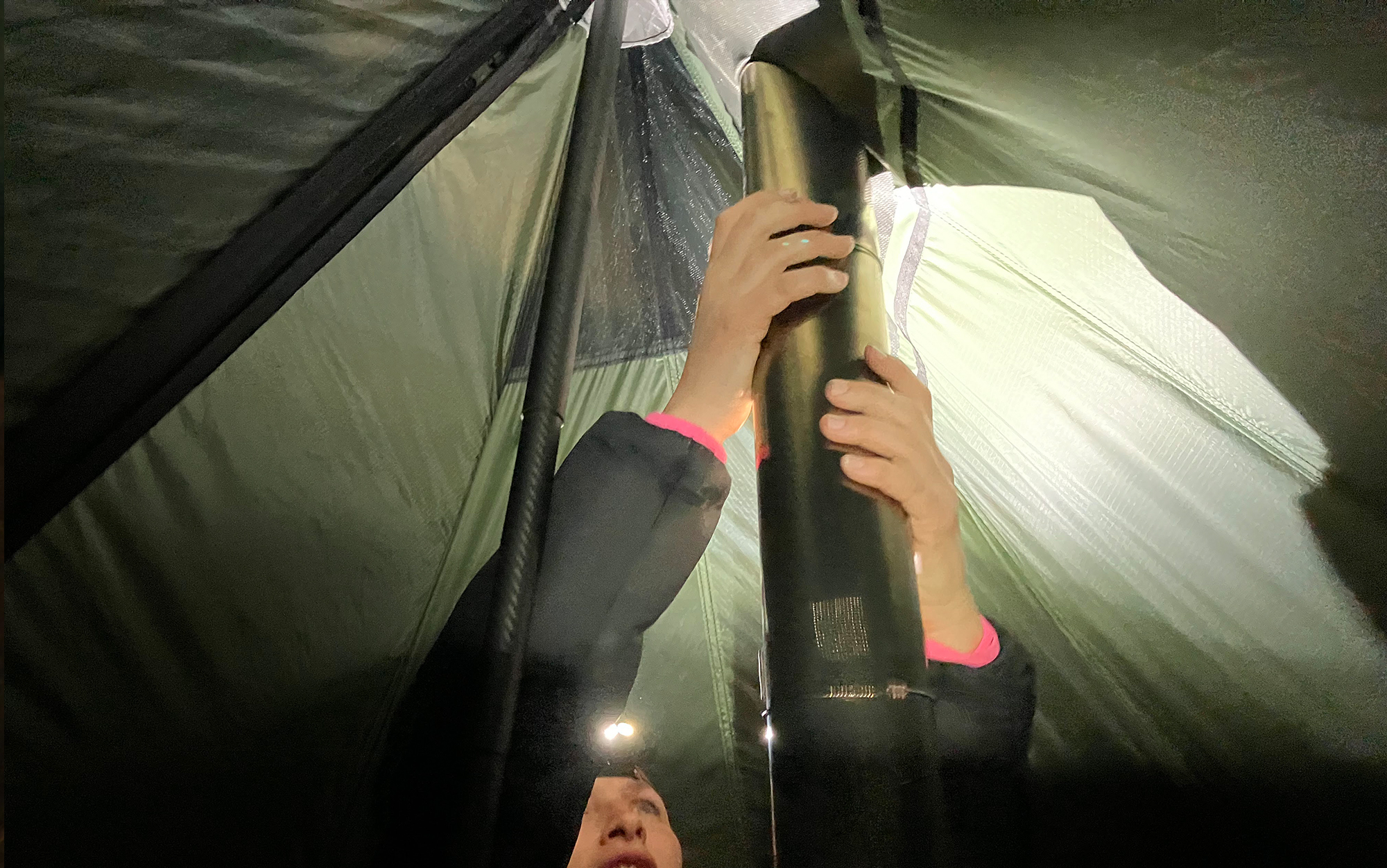
While Seek Outside markets this as a tent that will sleep two comfortably with the stove set up inside, my sense is that three careful hikers will do just fine. And all five of us fit comfortably chatting and eating in the tent at the end of the day.
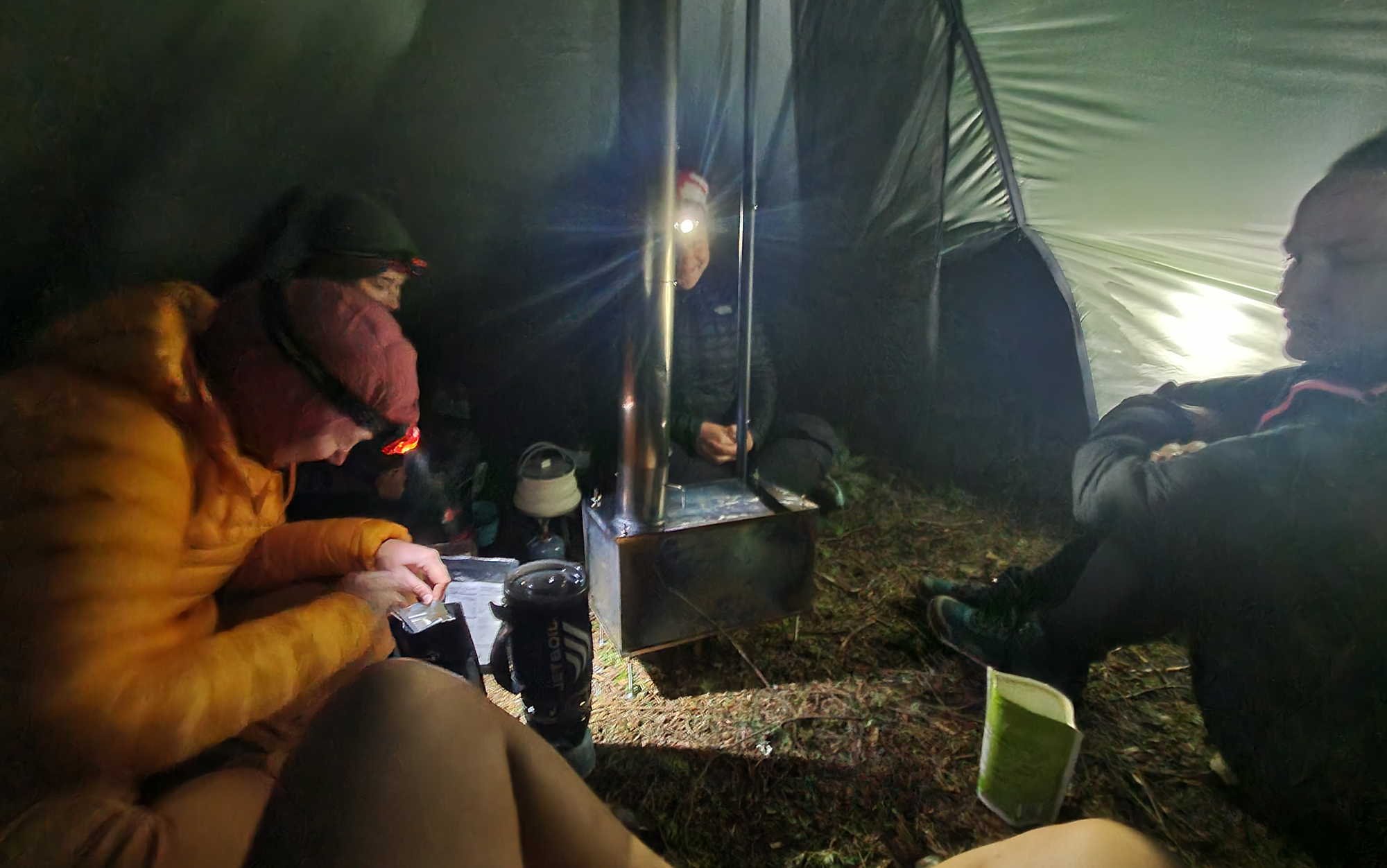
The only pitfall for this tent is that it can be a challenge to find a place for it. With the huge footprint and need to stake the tent down, you might spend more time searching for a spot to set up than actually setting up.
Best for Tall People: Tarptent Protrail
Report Card
- Measured Weight: 1 pound, 8.2 ounces
- Ease of Setup: 2
- Interior Living Space: 2.5
- Value: 4
Key Features
- Price: $240
- Interior Dimensions: 84 inches long x 42 inches wide x 45 inches high (width tapers to 30 inches at the foot)
- Requires two trekking poles set to 122cm and 81cm (fixed tent poles available for purchase)
- Stakes: Four required
- Materials: Ripstop nylon
- Also available in a lighter weight (and more expensive) material and as a two-person tent
Pros
- Usable length makes this a great option for taller individuals
- Could fit two people in a pinch
- Affordable
Cons
- Tends to sag in the middle in condensation-prone conditions
- Individuals with a shorter wingspan will struggle with setup
Plenty of people over 6 feet tall won’t even look at a one-person ultralight tent. After all, the easiest way for manufacturers to save weight and protect your UL bonafides is to simply make your tent smaller than the competition. And, to be honest, our all-women testing crew, which topped out at 5 foot 10, was mostly fine with that. But there was one ultralight tent we tried that was clearly built with an over six-foot individual in mind: the Tarptent Protrail.
While plenty of other ultralight tents claim a similar 84-inch length, few actually have that much usable space, due to the taper of the walls. Not so in the Tarptent Protrail, which has fully vertical sides at the top and the bottom of the tent. We think that anyone up to six foot four would be comfortable lying down inside this tent.

Unfortunately, getting in is a different story. The Tarptent Protrail was the only tent in our test that had head-in entry, which most testers found to be somewhat uncomfortable and awkward to use, especially when they were tired after a long day of hiking.
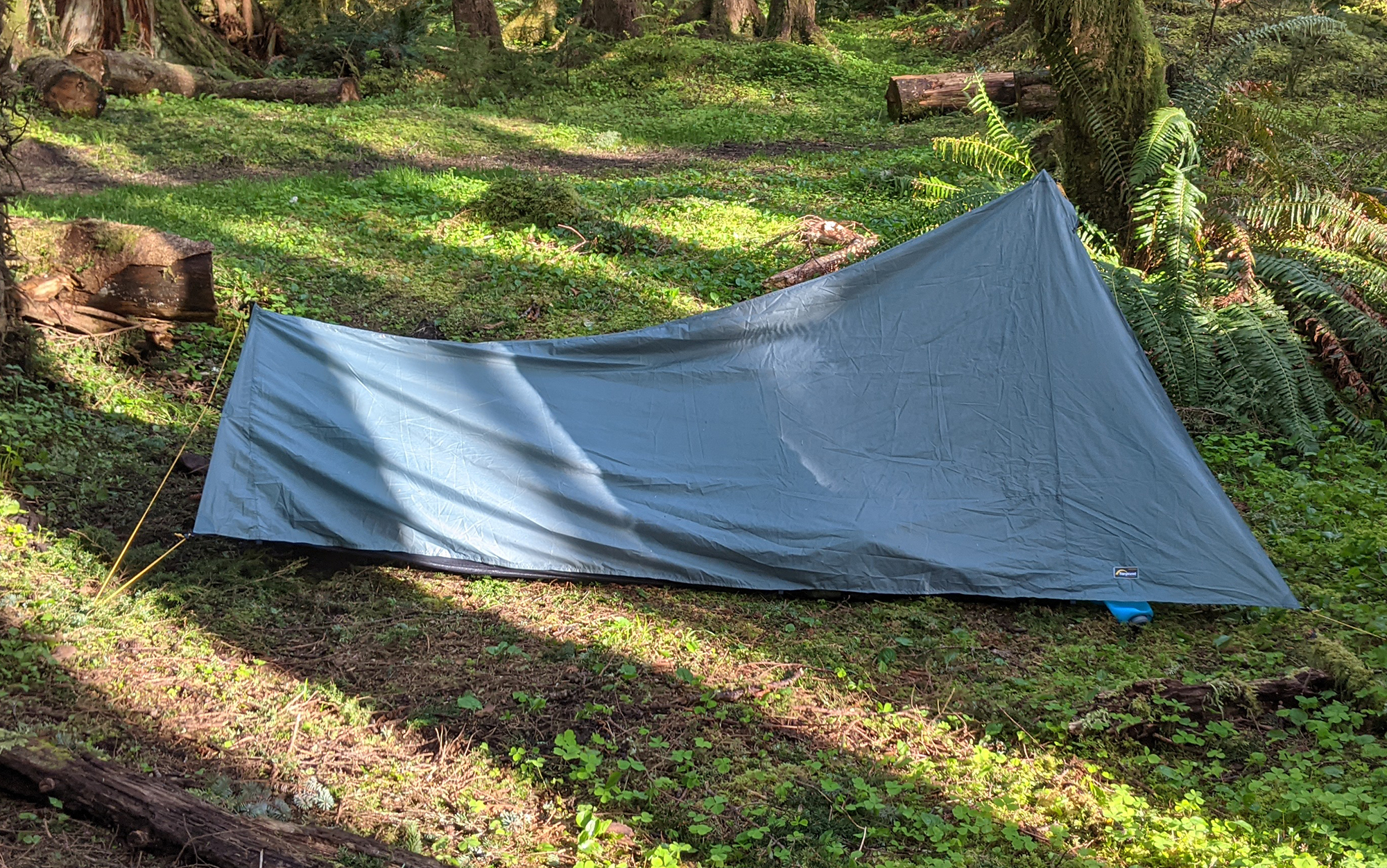
The two trekking poles used in the setup of the Tarptent Protrail were separated lengthwise, 84 inches from one another. That long profile, without any additional support or structure in the center, meant that it sagged more from the condensation than anything else we looked at. We would also have concerns about this tent in serious wind conditions if it was angled incorrectly or if wind was coming from multiple directions.
It’s worth noting that shorter people will struggle to set up this tent, as one of our testers discovered on the final night of our trip along the Oregon Coast Trail. That’s because the front trekking pole must be held upright at the same time as you stake out the far door: the wingspan of a shorter individual just can’t reach that far.

While the Tarptent Protrail wasn’t our favorite ultralight tent from this test, there are a number of other models from Tarptent that utilize side entry and trekking-pole-free setup that we hope to check out on future tests.
Lightest: Zpacks Plex Solo
Lightest
Zpacks Plex Solo
Report Card
- Measured Weight: 15.9 ounces (weight includes stakes; not included in purchase price)
- Ease of Setup: 2
- Interior Living Space: 2
- Value: 3
Key Features
- Price: $622 (price includes stakes; not included in base price)
- Interior Dimensions: 89 inches long x 38 inches wide x 52 inches high (width tapers to 28 inches at the head and foot)
- Requires one trekking pole set to 132cm (pole available for purchase)
- Stakes: Six to 10 required (not included in the purchase price)
- Materials: Dyneema Composite Fabric (DCF)
- Also available as a two-person or three-person tent
Pros
- By far the lightest tent in our test
- Single pole set up
Cons
- Expensive
- Experience needed to achieve the correct pitch
- Requires a taller trekking pole to pitch properly
Our testers had more mixed feelings about the Zpacks Plex Solo than anything else we looked at. The weight of this tent—the only one in our test to break the sub-one-pound barrier—is incredibly impressive. It’s also pretty darn expensive: twice the price of our best overall pick. The Dyneema Composite Fabric (DCF) that helps give this tent its low weight was also surprisingly insulative, with our tester noting that it was easily 5 degrees warmer inside than out. Nonetheless, if the pitch wasn’t just so, it felt, in the words of one tester, like “sleeping inside of a wet trash bag.”
The incorrect pitch was not for lack of trying. Our tester, who described the provided instructions as some of the best we looked at, spent a long time trying to get this one right. But then she’d get into the tent and realize something wasn’t quite right with one or more of the ten stakes. After getting out to adjust the stakes and the guylines, she’d get in again, and see that now something new was wrong. By morning, she was pretty frustrated, but other members of the testing trip who had used Zpacks before simply nodded sagely. The pitch on these tents is tough to master.

We also had concerns about its storm-readiness. Unlike other ultralight tents, there is no zipper on the door, just clips at the corners of the two sides that secure to a stake. That means rain and wind can both push their way through if you haven’t protected yourself by some other means. Experienced thru-hikers will know if this is a risk they are willing to take. After all, some trails are unlikely to see conditions that would make this an issue, and there is always the option to prop your backpack up in the door to provide some extra protection. But we think typical backpackers should think twice before committing to a setup like this.

If you’re new to ultralight tents, especially if you’re new to trekking pole tents, we think you should shelve this one for the time being and opt for a slightly heavier model like the Six Moons Lunar Solo. But if you’ve been using ultralight tents for some time, and are ready to upgrade to that elusive sub-10 pound kit, then this should absolutely be on your short list.

Like the Six Moons Lunar Solo, this one doesn’t come with stakes—you’ll need to buy those separately. While our first recommendation is for the MSR Groundhog Minis, that’s going to push you up over the one pound mark. To keep this under a pound in total weight (and get all ten stakes—you’ll need them to take full advantage of the interior space), go for the MSR Carbon Core.
The last note is to check your current trekking poles. The best pitch is achieved with a pole set to 132 cm in length, but some poles don’t extend that far.
Best Eco-Friendly: NEMO Hornet OSMO
Best Eco-Friendly
NEMO Hornet OSMO
Report Card
- Measured Weight: 2 pounds, 4 ounces
- Ease of Setup: 5
- Interior Living Space: 3
- Value: 4
Key Features
- Interior Dimensions: 87 inches long x 43 inches wide x 39 inches high (width tapers to 31 inches at the foot)
- No trekking poles required
- Stakes: Eight required
- Materials: Nylon ripstop, OSMO
- Also available as a two-person or three-person tent
Pros
- Eco-friendly materials
- Easy to set up
Cons
- Heaviest freestanding tent we looked at
In recent years there’s been growing awareness that what goes into creating these practically weightless waterproof tent fabrics isn’t always great for the environment. If this is starting to weigh on you (it’s starting to weigh on us), then the NEMO OSMO series is one to seriously consider.
NEMO is one of the backpacking gear companies leading the charge in creating more environmentally sustainable fabrics and processes. Their OSMO tent fabric is made from 100 percent recycled material (a composite of polyester and nylon) and achieves an impressive water repellency without the use of PFAS.
The NEMO Hornet OSMO is a freestanding tent that holds its own in the ultralight arena. It was just a couple of ounces heavier than the other freestanding tents we looked at (the Big Agnes Tiger Wall UL and MSR Freelite), with similar interior space and ease of setup. If you’re looking to reduce your impact on the environment, this is a great option that will keep your backpacking kit ultralight.
The Rest of the Field
The testers loved the Big Agnes Tiger Wall UL—another freestanding mainstay of the thru-hiking world—for its easy setup, protected interior, spacious vestibule, and mesh storage pockets.

While the MSR Freelite squeaked by with the lowest weight of the freestanding tents (and is our recommended pick for this category), the Big Agnes Tiger Wall UL is an excellent ultralight option.
The Outdoor Vitals Fortius was a new-to-us trekking pole tent which we had some mixed feelings about. Our tester ended up needing to watch a video on how to set it up in order to crack it (it was significantly less intuitive than the rest of the trekking pole tents in our test), and even then the final shape looked odd compared to the sleek elegance of other ultralight tents.

Happily, the interior was spacious and the low price coupled with low weight make this tent one to consider.
I’ll admit it; we struggled with the Stone Glacier SkyTarp UL. More than any other shelter option we looked at, this one is a masterpiece of geometry. If you set it up right, the weight to space to protection is off the charts. But get the setup even a little wrong, and it’s basically worthless. Unfortunately, getting it right requires a more advanced skill set than most backpackers have (brush up on your knot tying before attempting this one).

Snag the Stone Glacier SkyTarp UL if you are experienced with tarp setups and are looking for backup weather protection to your typical cowboy camping setup.
We similarly struggled with the Kuiu Summit Star, which was the most complicated tent to set up in this roster. Our most experienced tester spent forty minutes getting the pitch right on her first attempt, the longest she said she had ever spent setting up a new tent.

But there were details that stood out: an incredibly spacious vestibule (this was effectively the largest one-person ultralight tent we tested by a wide margin), great breathability, long length that will appeal to taller individuals, an optional vestibule floor. This would be the right choice for an especially patient individual looking for an ultralight basecamp. And it does look awfully sharp once it’s up.
The Samaya Opti 1.5 is one that we wanted to love. After all, this is the brand that brought us the Radical1, one of the best 4-season tents that weighs less than a pound and a half. And they were taking a different approach to the trekking pole setup here (external A-frame with a side entrance, easier to get in and out), which is always fun to play around with. Well, play around we did, but we just couldn’t get this tent to look right. We particularly struggled with the guyline on the back of the tent, which when pulled taut actually decreases the interior space of the tent. Surely an angle exists where this wouldn’t happen, but we did not find it during our test.

There were other problems too. The included stakes, the same as with the Radical1 that worked so well in snow, had poor hold in soft ground and bent when they hit hard ground. Adjusting the pitch of the trekking poles along the A-frame was also tricky, as pulling the guylines along the side taut tended to affect the angle and make the whole setup unstable. And while the vestibule was an impressive size, the advertised front porch option requires a second set of trekking poles—which you would only have if you were sharing this tent with another person. For us, this ultralight tent didn’t hit the mark (especially at this price point), but we’ll be watching to see what the innovative Samaya brand comes out with in the future.
How to Choose the Best Ultralight Tents
Freestanding versus Non-Freestanding
For the uninitiated, freestanding tents can stay up with just the poles inserted, no need to stake into the ground, while non-freestanding tents must be staked out in order to stand up. For years, experienced backpackers would tend toward non-freestanding tents, particularly those that incorporated trekking poles into the design, for the weight savings. Novice backpackers, on the other hand, would gravitate toward the simplicity and security of a freestanding tent, which was much easier to achieve a storm-worthy profile with.
In recent years, however, the difference in weight and ease of setup between freestanding and non-freestanding tents has started to shrink. Our pick for the best freestanding tent, the MSR Freelite, weighed less than several trekking pole designs we looked at, while the single trekking pole design of the Six Moons Lunar Solo was nearly as easy to put up as a typical cross-pole construction.
Trekking Poles
If you currently use trekking poles, then switching to a tent that incorporates them into the design can be a major weight savings. (If you do not, then you’ll want to incorporate the weight of the trekking poles or the substitute tent poles into your calculations before making a final decision). When choosing an ultralight tent, check that your trekking poles extend up to the recommended height—our test of the best ultralight tents was paired with our test of the best trekking poles, and we were surprised at how often the trekking poles we were using were too short for the tents.
Ease of Setup
There is a lot of variation in how easy or difficult ultralight tents are to set up. Some tents, especially freestanding tents, are so simple to set up that you don’t even need directions. Others seem to require endless fiddling to achieve the ideal setup, especially the first few times you use them. If you regularly hike until dusk or are heading into a part of the country where snap storms are the norm, choosing a tent where you can achieve a great setup lightning fast is essential.
Single versus Double Wall
Most tents are double wall tents, where the inner mesh body and outer rainfly are two pieces separated by an inch or so when set up correctly. This helps to prevent condensation—the moisture that collects as we exhale during the night—from getting our gear wet when we brush up against the tent walls. However, extra material means extra weight, and ultralight purists typically opt for single wall tents that emphasize ventilation. However, as our extra condensation-prone backpacking gear test along the Oregon Coast showed, sometimes no amount of ventilation will prevent rapid condensation build up. So you’ll have to decide which is more important: protection from condensation or a lower weight.
Vestibule Size
For this test, we looked exclusively at one person tents, which generally lack the interior floor space for more than one of the best backpacking sleeping pads. With these tents, a healthy size vestibule is important if you are carrying more than the bare minimum of gear.
Seam Sealing
Seam sealing is essential to waterproofing the seams of a tent. Not all ultralight tents seam seal their tents automatically—some offer their tents at a lower price with the understanding that the consumer will seam seal it themselves. If you do not want to seam seal your own tent, double check whether this is provided automatically or as a separate service before purchasing.
Stakes
Lightweight stakes with excellent holding power are essential for non-freestanding tents. However, not all ultralight tents come with stakes at the point of purchase. Others don’t come with stakes that are appropriate for challenging terrains or conditions. I’ve noted in the above reviews where stakes will need to be purchased separately and when you should consider swapping out the provided stakes for one of the best tent stakes.
FAQs
Ultralight tents typically weigh between 1 and 2 pounds for a one-person model, with some freestanding ultralight tents weighing as much as 2.5 pounds. A two-person ultralight tent will typically weigh about a pound more than their single person counterparts.
Ultralight tents are typically made from DCF (Dyneema Composite Fabric), silnylon, or silpolyester. Poles and stakes are generally made from lightweight aluminum (look for high quality poles, like those from DAC) or sometimes carbon fiber.
If you’re new to ultralight backpacking, it’s best to start with an ultralight tent. While tarps are an excellent ultralight option, their ability to handle certain weather conditions is limited and they require significantly more experience to achieve a weather-ready setup.
Final Thoughts
There has never been a better time to upgrade your backpacking tent to an ultralight model. The ingenuity and diversity of design and construction means that it’s easy to find a tent that fits your needs, current kit, and experience level. After testing these tents first-hand in the field, we’re confident that they’ll shave ounces (and even pounds) off your base weight while still providing the quality sleep you need to make the most of your next outdoor adventure.
- Best Overall: Gossamer Gear The ONE
- Best Value: Durston X-Mid 1
- Best Freestanding: MSR Freelite
- Best Single Pole Set Up: Six Moons Lunar Solo
- Best for Groups: Seek Outside Cimarron
- Best for Tall People: Tarptent Protrail
- Lightest: Zpacks Plex Solo
- Best Eco-Friendly: NEMO Hornet OSMO


